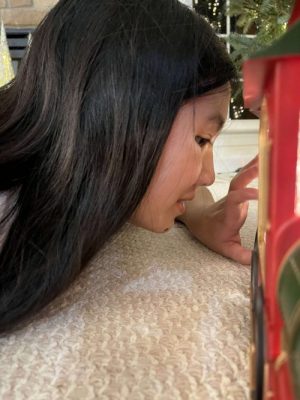Family Excited About New LCA5-Lebercilin Research Program
John Mills says he would crawl over broken glass if it led to a cure for his daughter’s visual impairment caused by one of the rarest of rare inherited retinal diseases.
Fourteen-year-old Naomi Mills of Virginia lives with one of the rarest forms of Leber congenital amaurosis – LCA5, which encodes the protein lebercilin. Lebercilin is responsible for moving proteins up and down, between the inner and outer segments of the photoreceptor cell so it can operate properly and stay healthy.
While most parents of children diagnosed with a rare inherited retinal disease can identify with John’s feelings toward finding a cure, a new genetics company just might save his hands and knees from harm, as the business plans to prioritize research into this severe form of LCA that affects about one in 1.7 million people.
Opus Genetics based in Raleigh, N.C., plans to file an Investigational New Drug (IND) application this year with the U.S. Food and Drug Administration for an LCA5 research program called OPGx-001.

Naomi Mills, who lives with a rare form of LCA knowns as LCA5-Lebercilin, loves this Christmas train ornament because it moves and it’s colorful and sparkly.
A pharmaceutical company obtains FDA permission to start human clinical trials and to ship an experimental drug across state lines through an IND application before approving a marketing application for the new drug.
“Kathie (John’s wife) and I pray every day that there’ll be a pathway to improve her vision, that she’ll be able to drive someday.”
The Retinal Degeneration Fund (RD Fund), the venture arm of the Foundation Fighting Blindness led the $19 million in seed financing. The funding will allow Opus to advance the preclinical work of its three scientific founders: Jean Bennett, MD, PhD, the F.M. Kirby Emeritus Professor of Ophthalmology at the Perelman School of Medicine at the University of Pennsylvania; Junwei Sun, Chief Administrator for Penn’s Center for Advanced Retinal Ocular Treatments; and Eric Pierce, MD, PhD, the William F. Chatlos Professor of Ophthalmology at Harvard Medical School and Massachusetts Eye and Ear.
“We’re very excited,” John said. “We know there’s a lot of moving parts here – doctors, advocacy groups, medical research, the FDA. Trying to get all of those aligned for the moon shot is quite an orchestration.”
High Aspirations for Teen with LCA5
Low vision aside, her father said Naomi wants the freedom of mobility in owning a car.
“Naomi was given a suggestion by her wonderful teacher that a best practice is to buy a car, even if you’re blind, so you can ask someone to ‘Please drive me in my own car,’” John said. “She also hopes that she can drive her own car someday.”
The couple’s daughter also loves music, plays piano, and wants to be a filmmaker.
How can a person with visual difficulty make a film? Naomi did on a recent Sunday afternoon, John said, documenting the finishing of the family basement, recording clips of action, inserting music, and editing everything into a film.
“It’s beautiful,” he said. “She’s very good at whipping films together.”
He also said Naomi is her own person.
“She wants to grow up and move out as fast as she can and get her own place and live on her own. That’s a good thing,” John said. “She just loves the thought of being independent. That’s a good thing. We encourage that.”
Naomi and her family vacationed in Germany in 2018 and visited the Dialogue in the Dark exhibition at Frankfurt’s DIALOGMUSEUM, where blind guides lead visitors through settings in absolute darkness. John characterized the experience as a wonderful way to better understand the world of people with visual challenges. He said the Mills family would like to establish a similar exhibit in the United States.
With 20/500-600 vision, Naomi needs bright light, and, while colorblind, she can see contrasts and large black letters on white paper.
“My understanding and interpretation is that Naomi has tunnels of goodness that she can see out of. It’s like looking out of a wiffle ball, tunnels she can see through but not consistently,” he said. “She can read large print and she can write fairly well. She’s also proficient at reading and writing braille.”
Confirmed LCA5-Lebercilin Diagnosis
The couple adopted Naomi in 2010 at age 2 from China, knowing doctors diagnosed her with Retinitis Pigmentosa, and said, “We’re taking her on faith. It doesn’t matter.”
Their son, Michael, now 31, accompanied his parents to China when they adopted their first daughter, Sarah, from an orphanage in 2001. Sarah, now 21, went to China with John and Kathie when they brought Naomi home from foster parents nine years later. Back in the United States, the couple followed up any leads to help Naomi with her vision.
“It was very murky and confusing, trying to connect with resources and groups,” he said.
The family received Naomi’s confirmed genetic diagnosis after a visit to a doctor at the National Institutes of Health. Kathie became highly proficient in braille and initially homeschooled Naomi, who now attends the Virginia School for the Deaf and the Blind.
In the past several years, Naomi made the national finals in the Braille Challenge, the only academic competition of its kind in North America for students who are blind or visually impaired.
“She is so sharp, so smart, and such a blessing,” Naomi’s mom said.
